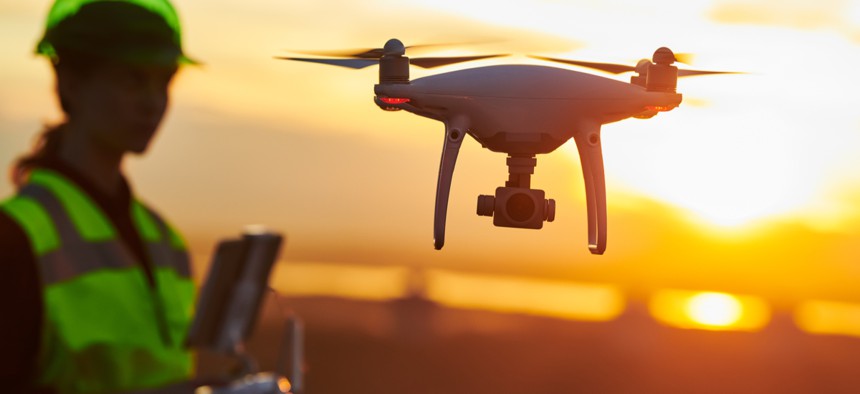Agencies Could Stretch Budgets By Embracing Drones

Dmitry Kalinovsky/Shutterstock.com
Shifting time-consuming manual work to drones could free up valuable personnel hours.
In recent years, the government and hobbyists alike have begun using unmanned aerial vehicles for everything from battlefield surveillance to videography. The Federal Aviation Administration predicts the number of UAVs in existence will more than double from 1.1 million in 2017 to 2.4 million units in 2022. Many applications of drone technology remain untapped, and some overlook its most prominent benefit: cost savings.
In civilian and military agencies, drones controlled by mobile devices are used for real-time monitoring, remote sensing, search and rescue, surveillance, agriculture maintenance and infrastructure inspection. Drones provide optimal means for reconnaissance and observation, reducing—if not eliminating—the need to deploy anyone to a location for in-person observation. While this technology makes mission-critical tasks more streamlined and effective, it ultimately makes them more economically viable as well, considering agencies could save billions of dollars by using drone technology for previously manual surveillance and observation missions.
Stretching Budget Dollars
In situations where drones can adequately replace manned aircraft and the need for human involvement, federal agencies could save money by implementing drone technology and reallocating personnel hours to more complex missions that require problem-solving and critical thinking.
For example, civilian agencies could use drones to collect images and remotely update situational intelligence databases like those used by the FBI, saving time and money spent on manual research and maintenance. Search and rescue, additionally, is expensive with traditional manned aircraft. Using helicopters and other manned vehicles to track down a missing person or persons can often take days or weeks and requires special training, permits and mission hours. Opting for drones could be more efficient in mission-critical situations and save upward of a million dollars, which when reallocated could provide other projects and initiatives the support they need to succeed.
Proper Allocation of Resources
Failed missions cost agencies resources, manpower and time. By using drones to gather intelligence prior to taking action, agencies can reduce the risk of unsuccessful missions. Agencies are able to more strategically deploy the assets they have on the ground when equipped with the information they need to accurately interpret a situation.
Drones also can collect information for analysis in real-time, reducing the need for manual data capture and reporting. With this, agencies have access to the info they need immediately, facilitating faster, more accurate decision-making to get the job done right the first time.
Both military and civilian agencies are shifting from traditional surveillance to an “electronic battlefield” – a world in which readily available technology is used to improve communication, reduce risk and save valuable time. Whether that “battle” is international warfare or land in need of agricultural maintenance, drone technology is optimizing the future to keep troops and civilians safer while supporting successful missions.
Keith Mahler is senior account manager for the Army at Panasonic.





